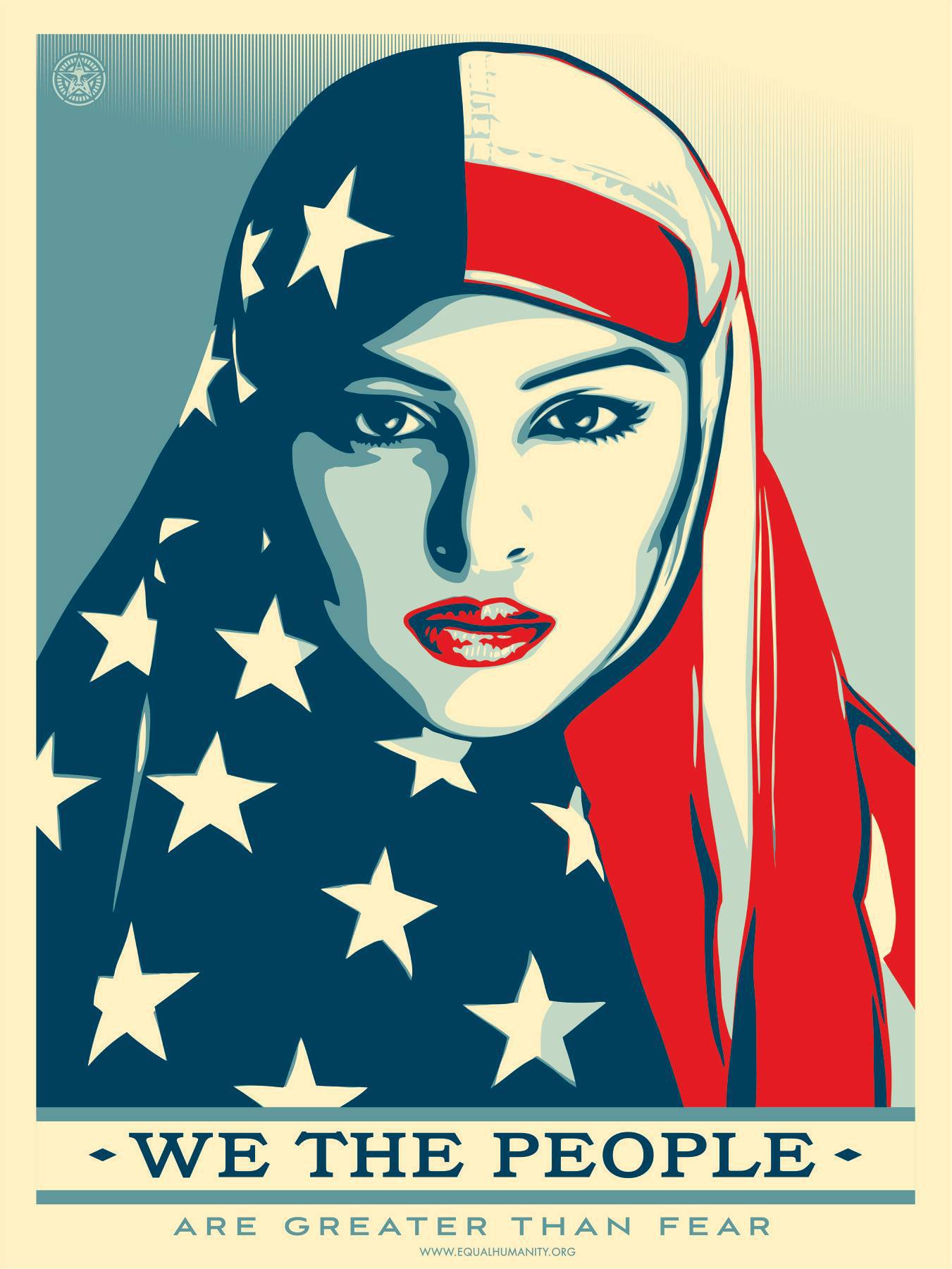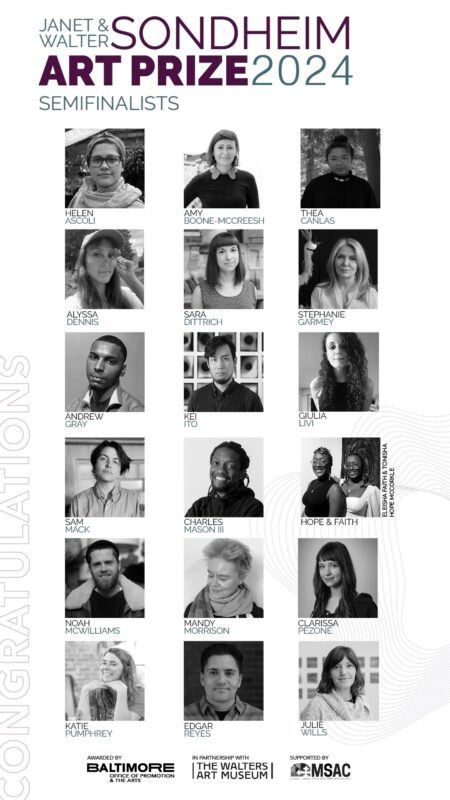Controversy over Shepard Fairey’s “We the People” Images at Westminster High School Displays Knee-Jerk Ignorance by Cara Ober
I am a graduate of Westminster High School. I received a solid education in Carroll County Public Schools and even taught art there for a few years. As a teacher, I distinctly remember a losing battle in the late 90s with students who displayed the Confederate Flag at school, which is one reason I migrated south to Baltimore. From an insider’s perspective, my Alma Mater’s recent and highly public scandal over multicultural art deemed “political” is telling.
After teachers at WHS hung Shepard Fairey’s “We the People” images in their classroom last month, which depict Muslim, Latina, and black women, they were removed for being “political” and “anti-Trump.”
Fairey is an internationally known artist and no stranger to controversy. After he designed the wildly successful “Hope” posters featuring President Barack Obama in 2008, a scandal ensued over ownership of the image and its monetary success. Like the “Hope” image, the “We the People” series is rendered in red, white, and blue with bold graphic shapes and feel-good messages like, “We the people are greater than fear.”

After Donald Trump’s rise to power, founded upon the racist ‘Birther’ Movement, which grew to include insults to a dead Muslim American soldiers’ family, threats to deport “thugs” and “bad hombres” to Mexico, a Muslim ban, and a wall with Mexico, it appears that basic human decency is the reason teachers hung Fairey’s posters in their classrooms.
Even though Carroll County is 93% white and overwhelmingly Republican (county politicians proclaimed English as the official language in 2013, as if that were necessary), there are a few educated liberals and minorities living there. In this case, teachers wanted to comfort their minority students who feel, rightfully, under attack by our new President, his administration, proliferating hate crimes across the country, and insulting political language picked up by other students. (All you have to do is quote the president verbatim and you’re going to insult someone.) Teachers hung these posters to promote American values where diversity is at the center in order to help vulnerable minority students feel supported.
As reported by the Carroll County Times, at least one staff member complained about the posters and teachers were “asked to take them down because they were being perceived as anti-Trump by the administration,” said Carey Gaddis, a spokesperson for Carroll County Public Schools. After taking the posters down, the teachers were initially allowed to put them up again. “But the administration did some further investigation online and determined that the posters could be seen as political,” reported the CC Times. The school does not allow teachers to put up political posters in their classrooms “unless it’s part of a curriculum and they represent both sides,” Gaddis said.
The school board is obtaining legal counsel to clarify the First Amendment rights of students (they have them) and teachers (they don’t in the workplace) and the controversy has generated negative press for the school and county from the Huffington Post, Washington Post, Baltimore Sun, and more. While these articles have reported the facts and celebrated a student-run campaign to crowd source a protest on March 1, where pro-diversity students will wear T-shirt versions of Fairey’s posters, I’m shaking my head that this is happening at all.
Since when is art banned from the classroom? Art is, by its very nature, controversial. It provokes. It reflects the time an artist inhabits. Art is a source of cultural literacy, human achievement, and cross cultural understanding.
Art is also a “floating signifier.” This means it can be used for any cause or to represent any idea. An artist’s intension for the work has very little to do with the way it is perceived and received in the world. In short – it’s subjective.
Carroll County School’s administration made a choice to politicize Fairey’s diversity posters and ban them, claiming that they are partisan propaganda because they were used in Women’s Marches around the world. But what about other political art? Will Carroll County public schools ban Jenny Holzer and Hans Haacke from classrooms?
Will teachers no longer be able to display Picasso’s “Guernica” because it protested the Spanish Civil War or Jacques-Louis David’s “Death of Marat” because it was aimed to promote the French revolution? Surely, these are “political” works of art, too? Where does this school system draw the line?

Looking back through art history, it actually becomes difficult to find any works before the Renaissance that don’t promote a religious or political agenda. Sculptures of Roman Emperors and Egyptian Pharaohs? Nope. Political propaganda all. Michaelangelo’s “Sistine Chapel Ceiling”? Religious. Political. Catholic propaganda.
Where does Carroll County Schools draw the line, Superintendent Steve Guthrie, Assistant Superintendent (and my former Spanish teacher) Steve Johnson, and Carey Gaddis?
It appears that Shepard Fairey’s artwork, political or not, has been targeted not because of a policy of banning political art, but because it represents ideas that are not appealing to the majority of Trump-supporting Carroll Countians. It seems that Carroll County Public Schools only have a problem with political art that is relevant to current political issues.
In banning such works of art, based on one person’s reported complaint in a highly charged and ugly political climate, this administration, surrounded by ultra-conservative voters, has opened up a can of worms that confirms the worse biases among students, exactly the opposite of what they need to learn.

So what if these posters were used to protest Donald Trump in the Women’s March? They don’t mention the president. Rather, they serve to combat a casual racism that pervades the region.
So what if they are “perceived” to be political? Art can mean anything to anyone at any time. Art is completely subjective. We live in a world where French fries have been “perceived” to be political. It’s time to stop this nonsense and stand up for what is right.
Rather than making a knee-jerk and predictably racist reaction to a tiny public school controversy, Carroll County Schools’ leaders could have stood up for principles they claim to support: diversity, equality, and educational discourse. Moving forward, I suggest they read up on the awesome power of art to shape hearts and minds, to educate students, to stand up for oppressed people, and to start revolutions.
In the meantime, students and alumni are leading where their teachers and administrators have failed. A Go Fund Me Campaign was founded by 2012 WHS graduate Sarah Wack and it has already surpassed a $4000 goal so that students can protest wearing shirts that bear images from “We the People” on March 1. “Making classrooms feel safer for minority students has unfortunately been mistaken for partisan speech in the current political environment,” said Wack on the fundraising page.
An additional alumni rally has been planned for March 3 outside the CC Board of Education building to show support for diversity in the area’s schools and to criticize the decisions made regarding Fairey’s images at WHS.
Just like Elizabeth Warren’s recent and seemingly senseless silencing on the floor of Congress, the attempt to shut down progressive voices is back-firing on officials with negative press and less favorable views of the county from across the country.
I am proud to stand with WHS alumni who are protesting this ridiculous and unkind decision. I predict many of Fairey’s signs will be on display at the protest as well as ones stating, “And she persisted.”
***********
Cara Ober is Founding Editor at BmoreArt and a graduate of Westminster High School.
To support student’s Go Fund Me Campaign and Protest planned for March 3, click here: https://www.gofundme.com/we-the-people-stand-with-whs.






